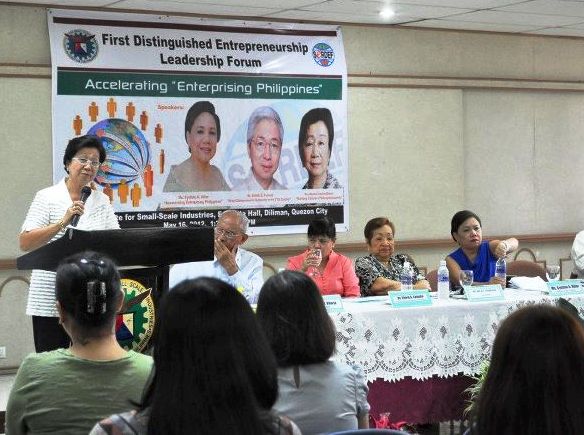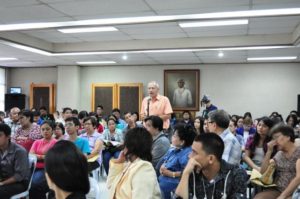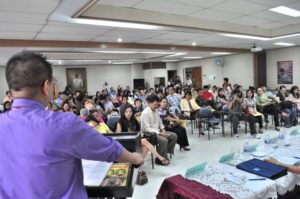Women as entrepreneurial leaders took center stage at the First Distinguished Entrepreneurial Leadership Forum organized by the Small Enterprises Research and Development Foundation (SERDEF) and the U.P. Institute for Small-Scale Industries (UP ISSI) yesterday, May 16, on the occasion of the SERDEF’s annual general membership meeting. (Click here to read full story about the meeting.)

Myrna Castro-Bituin, owner and founder of Betis Crafts, Inc. and Cynthia A. Villar, president of Villar Foundation, recounted their experiences, struggles, and insights starting and running their job-creating, income-producing enterprises, which though at first dissimilar in purpose and motivation, both ended up serving their communities and uplifting lives of the people they work with.
Mrs. Bituin’s handicraft venture started as a business enterprise, set up to earn profits, while Mrs. Villar’s was put up, at the outset as a social enterprise whose objective is to create social change. Both nevertheless succeeded in empowering their workers and inculcating the enterprising culture in their respective turfs. Bituin now, in fact, considers herself a social entrepreneur, after handing over the Betis business conglomerate to her children.
Another distinguished woman, UP Vice President for Development Elvira Zamora, delivered the inspirational message in behalf of UP President Alfredo E. Pascual. Her message underscored the UP’s vision to be a great entrepreneurial university in the 21st century by pushing is greatest assets — students, faculty, alumni, and staff — to global excellence and leadership.
The Betis story “in progress”
Mrs. Bituin’s venture started modestly in Betis, Guagua, Pampanga, with P10,000 capital, as a producer of wooden carcasses, growing in a matter of years into a high-end furniture manufacturing business catering to an international market. What used to be known as JB Woodcrafts is now a conglomerate of four companies, managed by a Bituin son or daughter each, which together integrate the various aspects of furniture-making.
For example, South Sea Veneer Corporation, headed by daughter Lieza Marie Bituin, specializes in lamination, marquetry and parquetry, and is thus supplying Betis Crafts’ table tops.
Mrs. Bituin attributes the growth of Betis Crafts to productivity measures laid in place in all four factories. “To stay in the race, you have to be very good at what you are doing,” she said. For this reason, the company has invested in year-round programs on raising productivity and skills among workers and inculcating productivity values. For example wood carvers undergo continuing training as carving is considered the company’s strength and competitive edge.
She is proud to have handed down to her children not only a productivity-oriented management style but also an entrepreneurial motivation that goes beyond profit, quantity and product quality. “We work hard to improve the quality of life of our workers who have become part of our extended family.” We get involved in their personal and family problems – the breadwinner who pawns his ATM card to a loan shark, the worker embroiled in a child custody case, the family driver with a cancer-stricken wife. “We see to it our workers have food on their table, medicine when a child gets sick, money to send their children to school.” To her, “that is success in business.”
With Betis Crafts firmly established in both local and export markets, and with her children taking over most of the operations, Mrs. Bituin has herself moved on to social concerns such as environmental protection through a bamboo propagation project, rights and welfare protection for the differently-abled, culture and heritage preservation, waste segregation, and organic backyard gardening. Returns from these ventures will take long in coming, she admits. She may not even live long enough to see the projects bear fruits, she adds. But she takes comfort in that “there is always the next generations to prepare the future for.”
Mrs. Bituin prefaced her talk by recalling that she was once a “student” of UP ISSI. She was referring to the Department of Science and Technololgy’s MPEX project implemented by ISSI and SERDEF which deployed consultants to export-oriented manufacturing enterprises for the purpose of raising operational efficiency.
Villar Foundation’s see-a-need, fill-a-need slogan
 Villar Foundation’s entrepreneurial philosophy of “see-a-need, fill-a-need” gave impetus to its various programs designed to uplift the livelihood of urban-poor communities in Las Pinas, Rizal.
Villar Foundation’s entrepreneurial philosophy of “see-a-need, fill-a-need” gave impetus to its various programs designed to uplift the livelihood of urban-poor communities in Las Pinas, Rizal.
An entrepreneur should be aware of the surroundings and from such awareness spot an opportunity to help, to improve things. For Cynthia Villar, president of Villar Foundation, widely regarded a role model in social entrepreneurship, the role of the entrepreneur is to improve lives. Profit is only secondary: you use it to further help people.
This is apparently how Villar Foundation’s community enterprise projects in water hyacinth basket weaving, coconut coir and peat manufacturing, handloom basket weaving, composting and vermi-culture, parol-making, and bamboo propagation started and flourished.
With such projects, the Foundation has succeeded in creating an “army of entrepreneurs” rather than an “army of employees” or job seekers most of whom, unfortunately would end up joining the throngs of the unemployed.
This is how Mrs. Villar sums up how Villar implements a project : “Find a need or market, find the technology to produce the product or service that would fill the need, train the people to use the technology, and raise capital to purchase the technology.”
To those who get discouraged from their entrepreneurship goals by lack of capital, she has this to say: “It is not such a big obstacle. Once you are able to prove you know what you are doing, there will be higher confidence in you among sources of capital.”
She urged entrepreneurs to approach government assistance agencies. Government can make technology accessible and affordable to small businesses. It was UP Los Banos, for example, that assisted Villar Foundation’s livelihood projects to adopt technology.
On the other hand, she suggested ways by which government can further help entrepreneurs such as by providing a marketing platform that will bring buyers and suppliers together, by making accessible downloadable business and accounting forms online, by exempting micro and small businesses from minimum wage and other regulations, and even by providing subsidies to selected industries that need that extra push to become globally competitive.
More business management tips
 In the open forum that followed, moderated by SERDEF Executive Director Nestor Raneses, more entrepreneurial wisdom were drawn from the two speakers.
In the open forum that followed, moderated by SERDEF Executive Director Nestor Raneses, more entrepreneurial wisdom were drawn from the two speakers.
From Mrs. Villar, these include:
“The best entrepreneurship education is to seek employment in the field you are interested in. Work and learn. Save money. Then put up a similar business. But put it up where it won’t directly compete with your ex-employer”
“Never give money to your beneficiaries. Money is liable to be spent whenever there is a family emergency. Instead, give training and make technology and equipment available.”
“You need not register with government outright. Register when you are big and stable enough.”
“Don’t try to do everything to your business. You will not grow if you don’t learn how to delegate. But knowing your business is good. That is how you become credible and win your people’s respect.
And from Mrs. Bituin:
“Don’t be afraid of competition. Don’t waste your time worrying about them. Devote your energies being steps ahead of them. Find out what you can do that would be difficult for them to copy. Kung sila ay naghahanap ng kung ano and kokopyahin, kayo naman ay dapat naghahanap ng kung ano ang bago.”
“To encourage your people to work well, they should be clear what they should do from start to finish. Training is important. The feeling of being appreciated, knowing they have done well – these will motivate workers to give of their best.”
“Persistence in getting help from government and other sources of assistance will pay off. We cannot do it all ourselves. Government is there to help us. Kung sino ang mahusay mangulit sa gobyerno, sila ang nakakatanggap ng tulong.”

